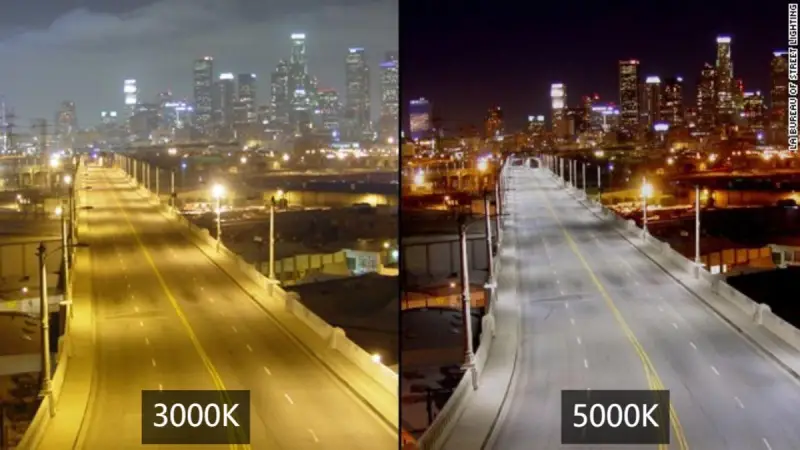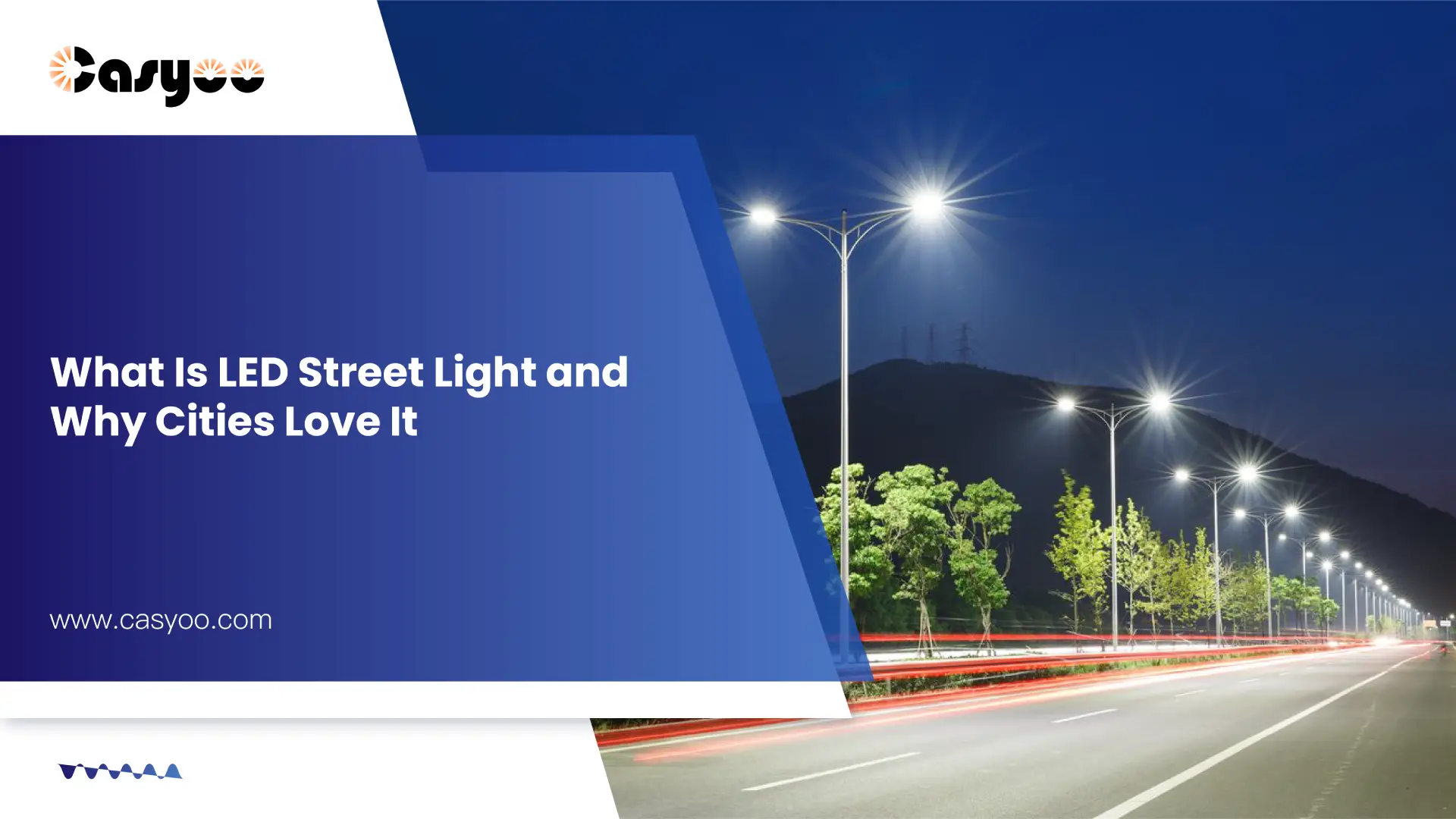Driving through downtown at night, I observed something amazing: the streets with the modern LED lights were safer, crisper, and somehow more alive. They weren’t simply brighter, however. Having worked as an LED lighting engineer for many years, I have seen directly how this technology has changed our cities. The light caught my attention, but so did the way people felt safe and comfortable under these bright spots, like they were in safe havens at night.
What is LED street light
The most recent advancement in urban lighting technology is represented by LED (Light Emitting Diode) street lights. In contrast to conventional street lights that use heating components or gas discharge, LED fixtures use semiconductor materials to create lighting, resulting in precise, adjustable light that is suitable to environmental requirements and human eyesight. Modern LED street lights can save up to 70% on energy costs when compared to traditional lighting thanks to this basic distinction, which allows for previously unheard-of efficiency.
The way that LED street lights incorporate cutting-edge technology into a comprehensive lighting solution is what makes them unique. High-efficiency LED chips, precise optics, and intelligent controls are all combined in each fixture to provide characteristics that are not achievable with conventional lighting, such as automated environmental response, smooth dimming, and rapid beginning. These lights provide a long-term, sustainable option for contemporary urban infrastructure because they don’t contain any dangerous components and have lifespans of over 100,000 hours.
Understanding LED Street Light Technology
Core Components
Every LED street light has a complex set of parts at its core that function flawlessly together:
LED Modules and Chips
LED chips are the powerhouse that produces light; think of them as your car’s engine. Modern LED chips achieve efficiency levels that were unthinkable just ten years ago by directly converting electricity into light using sophisticated semiconductor technology. For some mid-sized city lighting projects, they use the most recent generation of LED chips, which produced 160 lumens per watt—nearly double the efficiency of prior LED systems.
Heat Dissipation System
The idea that LEDs don’t produce heat is one that I frequently come across. Even if they use less energy than traditional lights, thermal regulation is still necessary. Compared to simple designs, our heat sink design can lower operating temperatures by up to 30°C because it uses aircraft-grade aluminum with unique fin patterns.
LED Drivers
Think of the driver as the system’s brain. It controls the flow of power and makes intelligent functions like remote control and dimming possible. Power factors above 0.95 are attained by modern drives, guaranteeing little energy waste.
Optical System
Art and science come together in the optical system. We can maximize visibility while reducing light pollution by precisely directing light where we need with carefully designed lenses and reflectors.
Protection Housing
The housing is developed armor, not just a shell. In order to provide years of dependable operation in challenging environments, contemporary LED street lights have IP66 rating enclosures that provide protection against dust and strong water jets.
Technical Specifications That Matter
When evaluating LED street lights, these are the key specifications to consider:
- Power Consumption: Typically ranging from 30W to 400W, depending on application
- Brightness: 3,000-40,000 lumens
- Color Temperature: 3000K-5000K (warm to cool white)
- Operating Voltage: 120-277V AC
- Power Factor: >0.95
- Lifespan: 50,000-100,000 hours

The Reasons LED Street Lights Will Shape Urban Lighting in the Future
Economic Benefits
For contemporary cities, LED street lighting is a game-changer. After installation, municipalities usually see an immediate 50–70% decrease in energy use. This equates to an average yearly savings of $50 to $70 per fixture at current energy prices. Although the initial outlay is greater than for conventional lighting, it often pays for itself in three to five years due to lower energy and maintenance expenses. Cities should anticipate saving $500–1000 per light in total ownership expenditures over the average 20-year lifespan of LED fixtures.
Sustainability Achievements
Beyond energy savings, modern LED technology offers quantifiable environmental benefits. Every converted fixture lowers 0.5 metric tons of carbon emissions each year. When compared to conventional lighting, the sophisticated optical design can cut light pollution by up to 50%, and the lack of mercury and other dangerous substances makes disposal easier and lessens the impact on the environment. Due to its longer lifespan—typically 100,000 hours as opposed to 20,000 for conventional lights—LED lighting drastically cut down on waste and the need for replacement materials.
Safety and Security Improvements
Public safety is greatly improved by LED street lights’ higher illumination quality. Unlike conventional sodium vapor lights, their high color rendering index (usually 70–80 CRI) enhances face and object identification. While the directional lighting minimizes shadows and dark areas, the instant-on feature guarantees constant illumination even in the event of power outages. In locations with enough lighting, these upgrades help to lower crime rates and traffic accidents.
Smart Integration and Modern Features
Network Connectivity
The foundation of smart city infrastructure is made up of contemporary LED street lights. In a wireless mesh network, any fixture can serve as a node, allowing for real-time control and monitoring. These networks use secure protocols to send information to central management systems regarding environmental conditions, operating status, and power usage. Remote programming and diagnostics are made possible by the connectivity, which greatly speeds up maintenance response times.
Sensor Integration
Multiple sensor types are included into advanced LED fixtures to maximize performance. Adaptive lighting applies motion sensors to light up when they sense activities. Temperature sensors keep an eye on the health of the system, while light sensors modify output in response to external conditions. Environmental sensors can monitor weather, noise levels, and air quality, giving planners and managers of cities useful information.
Smart City Applications
LED street lights can be used for purposes other than lighting. They can integrate functions like Security cameras, emergency alert systems, and WiFi hotspots. Through building different networks, they can also realize parking space management, traffic monitoring, and emergency response coordination. This multipurpose strategy offers crucial smart city services while optimizing infrastructure investment.
Choosing the Right LED Street Light
Technical Requirements
The criterion for selection must consider several significant technical factors. Depending on the application, light output needs usually fall between 3,000 and 40,000 lumens. Color temperature selections between 3000K and 5000K have an impact on the environment and visibility. Power usage, which usually ranges from 30W to 400W, should correspond with area needs. The fixture’s Ingress Protection (IP) grade should fit local environmental conditions. For outdoor installations, IP66 is the bare minimum.
Application Considerations
Different lighting solutions are needed for different situations. Street width, pole height, and spacing all influence the necessary pattern of light dispersion. While residential locations benefit from warmer color temperatures and less glare, commercial sectors could require more light and greater color rendering. The pedestrian activity patterns and traffic density can influence the selection of adaptive control elements.
Compliance and Certification
A number of certifications and criteria must be met by high-quality LED street lights. Seek accreditation from the Design Lights Consortium (DLC), which guarantees performance and efficiency criteria. Electrical safety requires UL/ETL safety certification. Test results from the LM-79 and LM-80 confirm claims about light output and lifespan. Products should adhere to energy requirements and dark sky ordinances in the area.
Installation and Maintenance
Installation Guidelines
Optimal performance and longevity are guaranteed by proper installation. Depending on the application, mounting height should normally be between 20 and 40 feet. To preserve the intended patterns of light dispersion, fixtures must be leveled properly. Electrical connections require proper grounding and surge protection. Network configuration and testing are required for smart features. Initial verification of the light level and programming of the control system should be part of the installation procedure.
Preventive Maintenance
The lifespan and performance of fixtures are maximized by routine maintenance. By cleaning optical surfaces once a year, we can maintain the light output efficiency. Water intrusion and structural problems are avoided by physically inspecting the mounting hardware and housing integrity. It is important to inspect electrical connections for corrosion and correctness. Diagnostics for smart systems can spot possible problems before they become problems.
Troubleshooting and Support
LED fixtures are very reliable, however sometimes they need maintenance. Sensor faults, network connectivity troubles, and driver failure are typical problems. The professionals will need to check components like the power supply, control signals, and optical components as part of a methodical troubleshooting procedure. For eligible problems, the majority of manufacturers offer warranty service and technical support, usually for a period of five to ten years.
Conclusion
More than just an improvement, LED street lighting technology is revolutionizing the way our cities are lit. LED street lights are an indispensable investment for contemporary urban infrastructure because of their energy efficiency, intelligent features, and long-term cost benefits.
Are you prepared to discover how LED street lighting can change your neighborhood? Contact our team of lighting experts for a personalized consultation and a free energy savings analysis. Let’s work together to build a more sustainable and bright future.




